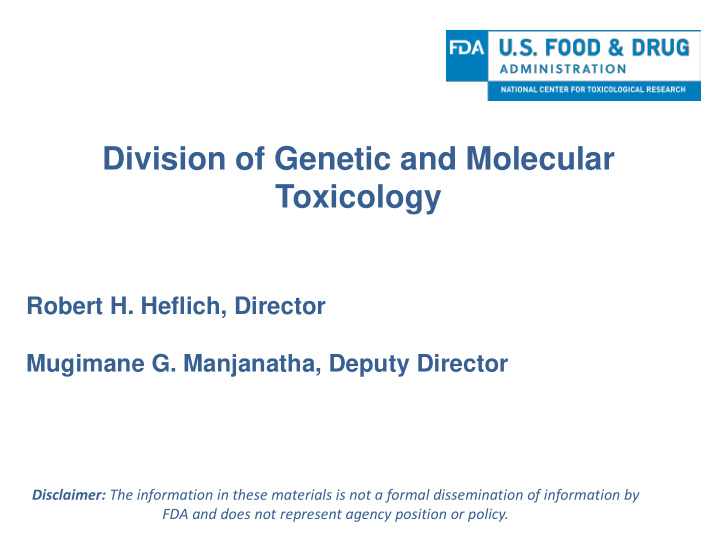



Division of Genetic and Molecular Toxicology Robert H. Heflich, Director Mugimane G. Manjanatha, Deputy Director Disclaimer: The information in these materials is not a formal dissemination of information by FDA and does not represent agency position or policy.
Current DGMT Staff • Government Positions — 27 full time employees • Research Scientists, Staff Fellows & Visiting Scientists : 14 • Support Scientists : 10 • Administrative : 2 • FDA Commissioner Fellows: 1 • ORISE Post Docs, Graduate Students, etc.: • 4 ORISE Postdocs (one externally supported) • Total = 31 2 www.fda.gov
DGMT Principal Investigators Investigator Standard assay/research projects/support Xuefei Cao In vitro human tissue models/CTP, NTP Tao Chen Ames test/genomics, nano, NGS/CTP Vasily Dobrovolsky Pig-a , in vivo and in vitro models/CTP Wei Ding Comet/immunotox/OWH Xiaoqing Guo MLA/quantitative methods, in vitro human/CTP Bob Heflich in vivo-in vitro MN/in vivo models, in vitro human models/CTP Manju Manjanatha Comet, in vivo-in vitro TGR/ assay development/CRADA Page McKinzie Cancer driver mutation, NGS Nan Mei MLA/quantitative methods, nano, assay development/CTP Meagan Myers Cancer driver mutations/OWH Barbara Parsons Cancer driver mutations/CRADA Javier Revollo NGS, Pig-a , gene editing/CTP 3 Patrice McDaniel Pig-a database
Outreach • Collaborations o NCTR Divisions: DBT, DSB, DBT, OSC o FDA regulatory Centers and Offices: CTP, CDER, CDRH, CBER, CFSAN, OWH o Government agencies: NTP, NIEHS o Others: UMD, UAMS, Harvard, UALR, TERA, Litron, Covance, BioReliance, Charles River , IIVS • Global leadership outreach o Organizations: OECD, International Workshop on Genotoxicity Testing (IWGT), ILSI/HESI o Others: St. George’s College (London), NIHS (Japan), Swansea Univ (UK), Teijin Pharma (Tokyo), Osaka Medical Center (Japan) 4 www.fda.gov
DGMT Mission (Vision) Improve public health by 1) providing the Agency with the expertise and tools necessary for comprehensive assessment of genetic risk and by 2) strengthening approaches to integrate knowledge of genetic risk into regulatory decision making. 5 www.fda.gov
DGMT Goals • Respond to Agency needs for chemical-specific data (e.g., nanomaterials, drug impurities, tobacco products) and assay expertise (e.g., CDER PTCC) • Maintain DGMT’s tradition of leadership in regulatory assay development and validation (Historical: MLA, Hprt , TGR; New: Pig-a, EpiComet Chip, Hairless Albino TGR): active in OECD, IWGT, ILSI/HESI and NTP assay development projects • Establish new paradigms for regulatory decision making that integrate measures of genetic risk with biomarkers of toxicity 6 www.fda.gov
Strategies for Establishing New Paradigms for Regulatory Decision-Making • Develop better biological models for assessing human risk that integrate genotoxicity with other measures of toxicity • Develop more comprehensive approaches for monitoring genetic variation • Develop better ways of evaluating data to determine human risk 7 www.fda.gov
Strategy: Develop Better Biological Models • Historically, genetox assessments have been conducted in bacteria, mammalian cell lines, and inbred (transgenic) rodents. Models that better represent human functions would increase value of data for evaluating risk. • Current projects: – Human (and rodent) in vitro organotypic models (E7549, E2200, E7623) – High-content/medium-throughput screening approaches using metabolically competent human cell lines and primary cells (E7608, E7609, C18001) – 3D tumor models (7551) • Proposed/in-development projects: – In vitro human, rodent, and alternative ( C. elegans ) germ cell models (C16037) – Adapting the Pig-a assay to measure mutation in male germ cells 8 www.fda.gov
Costar inserts Side view of the insert apical basal seeding • Pseudo-stratified structure expanding • Ciliated epithelial cells • Goblet cells • Basal cells Air-lifting • Tight junctions on the apical side (air-liquid-interface) 9
p63 Ki67 PAS Alcian Blue 10
--- Mucus secretion MUC5AC/5B quantification; hyperplasia of goblet cells --- Mucociliary clearance Cilia beating rate --- Tissue permeability (tight junction integrity) TEER measurement; immunofluorescence staining of tight junction markers Metabolism Ciliated cells Goblet cell Phase I & II metabolism Tissue structure changes Squamous metaplasia, epithelial hyperplasia DNA Damage Basal cells Comet --- Inflamma tory response Cytokine release; NF-kB activity --- Modification of extracellular matrix MMP activity; biomarkers of extracellular matrix regeneration
Tissue Exposure Systems • Whole cigarette smoke system (CTP) • Aerosol exposure • Vapor/gas exposure 12
Projects • Ongoing o E7549: Evaluating the toxicity and inflammation produced by cigarette smoke using human in vitro airway models (CTP) o E2200: Developing an in vitro system to evaluate the disease-related toxic effects of inhaled test agents in human airway tissue models (NTP) • Proposals/preliminary studies/ideas o Apply computational fluid dynamic modeling to scale in vivo to in vitro exposures (E7603) o Develop rat and transgenic rat versions of tissue models: apply parallelogram approach to in vivo and in vitro data in rats and humans (E7603) o Develop NGS sequencing approaches for measuring mutation in tissue models—develop TGR models? Pig-a gene mutation? o More complex models: adding cell types, combining tissues, MPS 13
Strategy: More Comprehensive Approaches for Monitoring Genetic Variation • Regulatory genetox assessments rely on DNA damage (Comet), cytogenetic (chromosome breakage), and reporter gene mutation data from cell lines and inbred (transgenic) rodents—i.e., using surrogate endpoints in surrogate systems for evaluating effects in humans — and are generally limited to performing hazard ID • Ongoing projects: o Using ACB-PCR to evaluate cancer driver mutations (E7229, E7336, E7438, E7551, E7619) o Using ddPCR and error-corrected NGS for evaluating cancer driver mutations (E7630) o Using error-corrected NGS to evaluate Pig-a mutation in bone marrow erythroid and granulocyte precursors (E7587) • Proposed/beginning projects: o Using NGS for evaluating mutation transmission through germ cells (C16037) o Duplex NGS for rare mutation quantification (E7629) o High fidelity NGS and whole genome clone analysis (C15081) o Off-target effects of CRISPR-mediated genetic engineering in mammals (E7646) 14 www.fda.gov
High Fidelity NGS and Whole Genome Clone Analysis 15
High Fidelity NGS and Whole Genome Clone Analysis Preliminary data with in vitro mammalian cells (L5178Y, a cell derived from rat T lymphocytes) 16
Off-Target Effects of CRISPR-Mediated Genetic Engineering in Mammals 17
Off-Target Effects of CRISPR-Mediated Genetic Engineering in Mammals 18
Feedback Requested Questions, comments? Are we emphasizing the most productive areas for research? 19 www.fda.gov
Recommend
More recommend